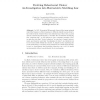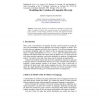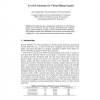ECAL
1999
Springer
14 years 7 months ago
1999
Springer
In 1961, Herrnstein [4] famously observed that many animals match the frequency of their response to different stimuli in proportion to the reinforcement obtained from each stimul...
ECAL
1999
Springer
14 years 7 months ago
1999
Springer
How can we expect an A-life Agent to learn how to perform tasks when it is not told what those tasks are, and it is not provided any indication or feedback as to its performance? ...
ECAL
1999
Springer
14 years 7 months ago
1999
Springer
Hinton and Nowlan have demonstrated a model of how lifetime plasticity can guide evolution. They show how acquired traits change the shape of the reward landscape in which subseque...
ECAL
1999
Springer
14 years 7 months ago
1999
Springer
We report on a case study in the emergence of a lexicon in a group of autonomous distributed agents situated and grounded in an open environment. Because the agents are autonomous,...
ECAL
1999
Springer
14 years 7 months ago
1999
Springer
We use a new general-purpose model of neutral evolution of genotypes to make quantitative comparisons of diversity and adaptive evolutionary activity as a function of mutation rate...
ECAL
1999
Springer
14 years 7 months ago
1999
Springer
In this paper, we present a possible implementation of arithmetic functions (notably, addition and multiplication) using self-replicating cellular automata. The operations are per...
ECAL
1999
Springer
14 years 7 months ago
1999
Springer
ECAL
1999
Springer
14 years 7 months ago
1999
Springer
Some recent Artificial Life models have attempted to explain the origin of linguistic diversity with varying conclusions and explanations. We posit, contrary to some existing Artif...
ECAL
1999
Springer
14 years 7 months ago
1999
Springer
One important implication of embodiment is that, by acting, agents partially determine the sensory patterns they receive from the environment. The motor actions performed by an age...
ECAL
1999
Springer
14 years 7 months ago
1999
Springer
This paper proposes a paradigm for specification of virtual human agents’level of autonomy. The idea we present in this paper aims at optimising the required complexity of agents...



